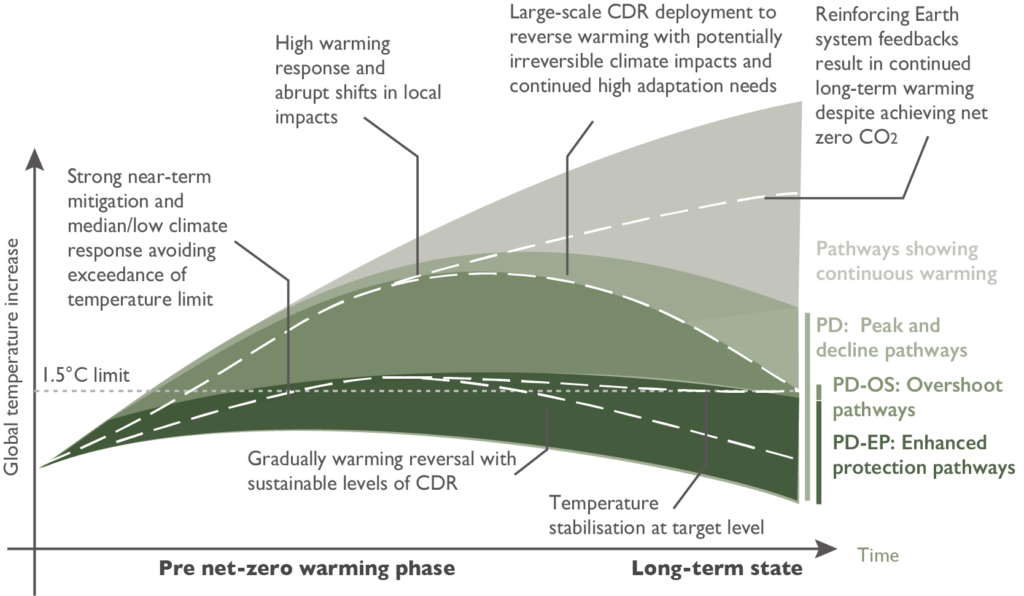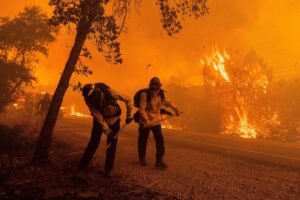
Guest post: How to minimise the risks from overshooting the 1.5C limit
Multiple Authors
10.09.24Multiple Authors
09.10.2024 | 4:00pmDespite progress since the Paris Agreement, a peak in greenhouse gas emissions is only just within sight – and time is fast running out to stay below 1.5C of human-caused global warming since the preindustrial era.
As a result, almost all pathways that keep 1.5C within reach now involve a temporary “overshoot”.
This term refers to a period where the best estimate of warming exceeds 1.5C, until temperatures are brought back below the limit by removing carbon dioxide (CO2) from the atmosphere.
While this idea is growing in prominence, there have only been limited efforts to understand what it would mean to breach the 1.5C limit, even if this is only during a temporary period of overshoot.
In a new Nature paper, we present the findings of a three-year Horizon Europe-funded project, looking at what overshoot means for emissions, temperatures, climate impacts and adaptation.
Our results show that overshooting 1.5C comes with significant uncertainty in terms of warming outcomes, climate impacts and associated risks. For example, climate uncertainty means that what is referred to as a 1.5C “pathway” carries a notable risk of much greater levels of warming.
In order to hedge against the risk of higher-than-expected warming, the world would need to develop substantial capacity for “net-negative” CO2 emissions. This could be used to reverse a temporary overshoot and reduce long-term risks, if warming is no more extreme than expected.
Even so, overshoot would come with irreversible consequences for humans and ecosystems, our research finds, such as rising sea levels and ecosystem loss.
Overshoot overconfidence
The Intergovernmental Panel on Climate Change (IPCC) has been key to shaping our understanding of overshoot scenarios. In its latest sixth assessment report (AR6), the IPCC considered a range of pathways that limit median warming in 2100 to below 1.5C.
The report categorised the pathways according to their probability of breaching 1.5C, but also offered information on the amount of any expected overshoot.
Specifically, the C1 “no or limited overshoot” pathways allow an overshoot of “up to about 0.1C”. The C2 pathways return warming to 1.5C “after a high overshoot” of between “0.1C-0.3C”.
These categorisations give the impression that overshoot can be neatly and confidently constrained – to within a few tenths of a degree – and that in choosing a particular pathway, the countries of the world would have full control over the planetary thermostat.
Crucially, however, the numbers refer only to median warming outcomes. Considering the uncertainties in Earth system feedbacks, it is not possible to rule out much higher peak warming. For example, this could be up to 2.5C under C2 scenarios (at the 95th percentile of all model runs).
If the increase in temperatures is indeed much higher than expected under median warming, or if warming continues even when CO2 emissions reach net-zero, then returning to below 1.5C after an overshoot would require much more CO2 removal than thought.
Even with stringent emissions reductions, we therefore cannot rule out the possibility that reversing a 1.5C overshoot would require the removal of hundreds of billions of tonnes CO2 by 2100.
Indeed, based on the simple climate model FaIR, our findings show that 400GtCO2 of additional removals could be needed to return temperatures to 1.5C by 2100, if warming reaches the 75th percentile of expected levels rather than the median (about 1.7C instead of 1.5C, an outcome with a likelihood of one-in-four).
(This is based on generating more than 2,000 physically plausible climate outcomes for an emission pathway that limits median warming to around 1.5C and achieves net-zero CO2 by around mid-century, without the need for net-negative emissions thereafter.)
To reach 400GtCO2 of removals by 2100 would mean taking nearly 10GtCO2 out of the atmosphere every year after global CO2 emissions reach net-zero. For comparison, current removals amount to around 2GtCO2 per year, from all sources.
The 400GtCO2 of removals that could be needed to deal with higher-than-expected warming is similar to the amount of removals that is typically being relied on in 1.5C pathways, assuming median levels of warming in response to a given level of emissions.
This is shown in the figure below, where the first row illustrates the range of cumulative CO2 removal needed to return temperatures to below 1.5C by 2100, depending on how sensitive the climate is to a given level of emissions. The bottom two rows show removals in C1 “no or limited overshoot” and C2 “high overshoot” 1.5C pathways, assuming a median warming response.

Our findings imply the world may therefore need a “preventive” capacity to remove hundreds of billions of tonnes of CO2 by 2100, to hedge against the risk of higher-than-expected warming.
Moreover, given the political, economic, sustainability and other constraints on the speed and scale at which CO2 removal can be scaled up, it therefore may not be possible to rely on removals to compensate for a failure to reduce emissions in other parts of the economy.
Irreversible impacts
If warming is no more severe than expected under median outcomes, then preventive CO2 removal capacity could be used to steadily reduce temperatures after overshoot.
This could be an important way to minimise long-term climate risks following overshoot.
For example, for every 100 years of overshoot above 1.5C, our findings show that there would be an additional 40cm of sea-level rise by 2300. There would be similarly irreversible consequences for the world’s frozen ecosystems, such as permafrost and peatlands.
In addition, overshoot increases the risk of crossing irreversible climate “tipping points”.
These findings show that even if a global temperature overshoot is reversed, the temporary breach of the 1.5C limit would still come with some irreversible consequences.
Peak and decline
Our study offers a framework for minimising the risks associated with higher-than-expected warming and potentially irreversible climate impacts after temperature overshoot.
Instead of the current categories of mitigation pathway, which focus on peak warming and end-of-century temperatures – apparently with a high level of precision – our paper suggests “peak and decline” (PD) scenarios that allow us to consider a wide range of plausible climate outcomes.
These scenarios aim to achieve a peak in warming, followed by sustained temperature reductions during a period of at least several decades. Global greenhouse gas (GHG) emissions would need to decline towards net-zero CO2 to achieve temperature peaking, followed by net-negative CO2 emissions to enter a long-term decline.
The “peak” is determined by how fast emissions are reduced in the near term, towards reaching net-zero CO2 emissions. This determines the maximum cumulative CO2 emissions of a pathway and therefore the level and timing of peak warming. Importantly, the stringency of non-CO2 GHG emission reductions will also strongly affect peak warming.
The pace of global temperature “decline” after the peak – and therefore the ability to reverse a temporary exceedance of a target limit – depends on the level of net-negative CO2 emissions that can be achieved.
In PD “overshoot” pathways (PD-OS), warming exceeds 1.5C before returning to that level and staying there into the future. These are similar to PD pathways, but the carbon budget, timing of net-zero CO2 and amount of CO2 removal depends on the length, level and timing of overshoot.
In PD “enhanced protection” pathways (PD-EP), warming is kept as low as possible and gradually reversed over time, to minimise climate risks. They entail stringent, rapid cuts in GHG emissions, achieving net-zero CO2 as soon as possible and using sustainable levels of CO2 removal to reduce warming over time, potentially reaching net-zero or even net-negative GHGs.
These pathways are illustrated in the figure below, where the 1.5C limit is shown as a horizontal dotted line, and the different peak and decline pathways are contrasted with a scenario in which temperatures continue to increase, despite reaching net-zero CO2.

Our findings suggest that a peak and decline “enhanced protection” pathway would offer the best way to hedge against the uncertainties and minimise the risks around overshoot and the response of the climate system. This would entail two actions from countries worldwide.
First, it would mean reducing emissions as fast as possible to slow down temperature increase, reduce peak warming, and reduce the dependency of needing large amounts of CO2 removals to even achieve net-zero CO2 emissions.
Second, it would mean rapidly scaling up global capacity for CO2 removal to hedge against high-risk outcomes from stronger than expected climate feedback.
The scale of preventive removal capacity that we estimate could be needed, is only just achievable within sustainable limits. If some removal capacity is used to compensate for a failure to rapidly reduce emissions, then it would not be available to manage higher-than-expected warming.
Overall, our paper reinforces the idea that earlier emissions reductions are the best way to minimise far-reaching climate risks in the 21st century and beyond.
Schleussner, C. et al. (2024) Overconfidence in climate overshoot, Nature, doi:10.1038/s41586-024-08020-9





